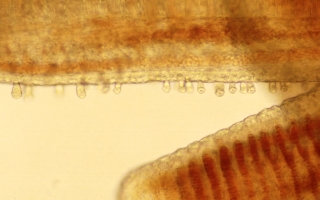 Scyphidia
sp.
Scyphidia
sp.
 Scyphidia
sp.
Scyphidia
sp.
Scyphidia sp. are free-living protozoans that are like Tricodina sp. and Epistylis sp. in that they filter microorganisms from the water and thrive in water of high organic content. Tilapia in Hawaii from brackish water environs often have Scyphidia sp. associated with the gill lamellae. Mild infestations are inconsequential to the fish.
Scyphidia sp. is a stumpy, cylindrical shaped protozoan that has a ring of cilia around the apical end and an expanded sucker shaped basal end where it is in contact with the skin of the fish. Scyphidia sp. have an elongated nucleus and when detached from the fish change to a saucer shaped form that is rapidly motile. When attached to tilapia Scyphidia sp. are about 40 þm in height. Scyphidia sp. is easily recognized in wet mount preparations of gills.
Scyphidia sp. are susceptible to most chemicals used to treat protozoan ectoparasites of fish. However, none of these chemicals have been approved by the FDA for use with tilapia. Transfer of affected fish to clear, water of low organic content may possibly rid the fish of Scyphidia sp. However, based on our experience in Hawaii Scyphidia sp. infestations have been mild and inconsequential.